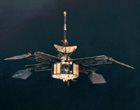|
|
Planet Mars
Tweet
Sunset on Mars
 Spectacular image of a Martian sunset taken by NASA's rover Spirit
Spectacular image of a Martian sunset taken by NASA's rover Spirit
Martian crater
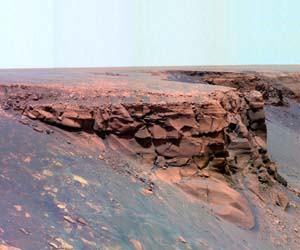 NASA's rover Opportunity explores the edges of a Martian crater
NASA's rover Opportunity explores the edges of a Martian crater
Planet Mars Facts
- Mars is the fourth planet from the sun, its diameter is only around 4,200 miles (6800 km) which is half the size of Earth.
- It travels around the sun every 687 days and rotates on its own axis every 24 hours 40 minutes.
- The average distance from Mars to the sun is around 142 million miles (228 million km), one and half times further away from the sun than our planet.
- The distance between Mars and Earth varies, from as little as 34 million miles (55 million km) to as much as 249 million miles (401 million km).
- There are vast amounts of ice under the Martian surface, most of it near the South Pole.
- Evidence shows that water used to flow on the surface of Mars.
- Mars has seasons just like Earth.
- Gravity on Mars is around two fifths of that on Earth.
- Clouds made from frozen CO2 form in the Martian sky. Haze and fog are also common.
- Dust storms on Mars can last for months and cover the entire planet.
Surface, Atmosphere & Temperature
Surface
Mars has similar surface features that exist on Earth such as plains, valleys and polar ice. The main difference is that craters occur all over the planet.
There are also mountains larger than Mount Everest.
Atmosphere
The thin atmosphere of Mars is only around 1% the density of our own atmosphere. It consists mainly of carbon dioxide 95.3%, the rest is made up of 2.7% nitrogen,
1.6% argon, 0.13% oxygen, carbon monoxide and water vapor make up 0.10%.
Temperature
Surface temperatures on Mars vary from as low as -125C (-195F) near the poles to as high as 20C (68F) at midday near the equator.
Moons, Name and Life
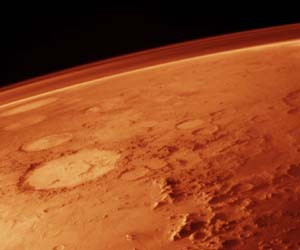
Mars thin atmosphere
Moons & Origin of Name
Mars has two very small moons, Phobos which has a diameter of 17 km (28 km) and Deimos which has a diameter of 9 miles (15 km).It is probable that they were once asteroids that were caught by the gravity of the planet.
Mars is named after the Roman God of War.
Life on Mars
Mars may once have harbored life and may still do today. Most likely life could exist in warm pockets beneath the ground, methane has been detected in the Martian
atmosphere which could have been produced biologically. In the summer months the amount of methane increases dramatically giving further credence
to this theory.
Colonizing Mars
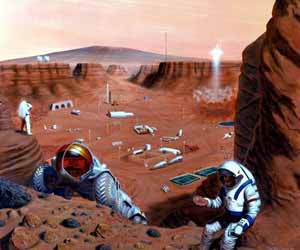
Images and Video
The Red Planet


Cloud movement over Mars
Mars North Pole
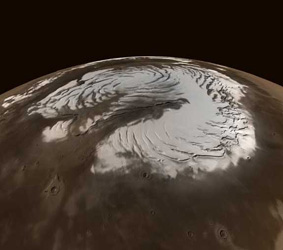

The surface of Mars (Pathfinder Lander)


Future and Past Missions to Mars
20.
ExoMars
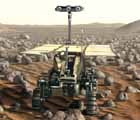 Launch: 2018
Launch: 2018Agency: ESA (Europe)
The ExoMars rover will be designed to search for life on Mars.
19.
Maven
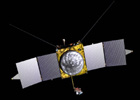 Launch: 2013
Launch: 2013Agency: NASA
The Mars Atmosphere and Volatile Evolution Mission will address key questions about Mars climate and habitability.
18.
Mars Science Laboratory (MSL)
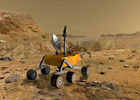 Launch: 2011
Launch: 2011Agency: NASA
MSL will be the next generation of Mars rovers, it
will employ a rocket and cable assisted descent mechanism in order to reach a landing site in more rugged terrain.
17.
Yinghuo-1
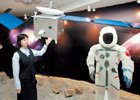 Launch: 9th November 2011
Launch: 9th November 2011Agency: CNSA (China)
China's first planetary mission will perform studies of Mars from an elliptical, equatorial orbit.
Update: Yinghuo-1 was on board the same rocket as Phobus-Grunt (see below for details).
Update: Yinghuo-1 was on board the same rocket as Phobus-Grunt (see below for details).
16.
Phobos-Soil (Phobos-Grunt)
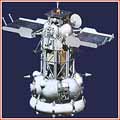 Launch: 9th November 2011
Launch: 9th November 2011Agency: RFSA (Russia)
Designed to land and collect samples from the Martian moon Phobos and storing them within a capsule, the craft will then pass by Earth releasing the capsule
which will be picked up for study.
Update: The Soyuz rocket carrying Phobus-Grunt launched successfully but unfortunately while in Earth orbit the engines which would have set it on course to Mars failed to fire.
Update: The Soyuz rocket carrying Phobus-Grunt launched successfully but unfortunately while in Earth orbit the engines which would have set it on course to Mars failed to fire.
15.
Phoenix
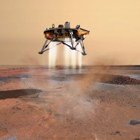 Launch: August 2007
Launch: August 2007Arrival: May 2008
Agency: NASA
Landed near Mars north pole to study the water ice found there.
14.
Mars Reconnaissance Orbiter
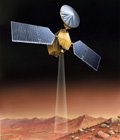 Launch: August 2005
Launch: August 2005Arrival: March 2006
Agency: NASA
MRO is searching for evidence of past water on Mars and also looking for future landing sites. It will also act as a communications relay for future missions.
13.
Mars Exploration Rover Opportunity
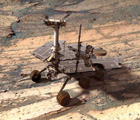 Launch: July 2003
Launch: July 2003Arrival: January 2004
Agency: NASA
Opportunity is still roving across the Martian landscape finding abundant evidence for the action of liquid water. It has survived many times longer than planned.
12.
Mars Exploration Rover Spirit
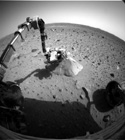 Launch: June 2003
Launch: June 2003Arrival: January 2004
Agency: NASA
Spirit had to rove several kilometers before it found evidence of past water. It is now exploring ancient Mars rocks preserved in mountains.
It has survived many times longer than planned.
11.
Mars Express
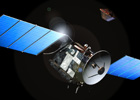 Launch: June 2003
Launch: June 2003Arrival: December 2003
Agency: ESA (Europe)
As it entered orbit Mars Express immediately began returning stunning 3D
color images. It also detected surprising levels of methane and evidence for recent volcanic activity.
Unfortunately the lander it carried, Beagle 2, apparently crashed into the Mars surface.
10.
Mars Odyssey
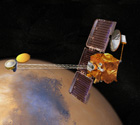 Launch: April 2001
Launch: April 2001Arrival: October 2001
Agency: NASA
Mars Odyssey is capturing images of the Martian surface and has detected massive deposits of water under the near polar regions.
It also serves as a communications relay for the exploration rovers.
9.
Mars Pathfinder & Sojourner
 Launch: December 1996
Launch: December 1996Arrival: July 1997
Agency: NASA
Successfully landed on the Mars surface, the six wheel rover
Sojourner also successfully rolled of the ramp onto land returning images and weather data.
The mission scheduled to last 30 days lasted almost 3 months.
8.
Mars Global Surveyor
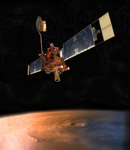 Launch: November 1996
Launch: November 1996Arrival: September 1997
Agency: NASA
Initially had problems on its arrival due to an issue with one of its solar panels. It wasn't until a year and a half later that it started returning a wealth of
data and high resolution images. Contact was lost in November 2006.
7.
Viking 2
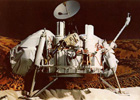 Launch: September 1975
Launch: September 1975Arrival: August 1976
Agency: NASA
The Viking 2 lander successfully touched down on the planet taking extensive atmospheric readings and conducting experiments on soil samples.
The lander functioned for 4 years observing several winters which covered it in an extremely thin layer of frost. The orbiter was shut down in July 1978. Between them the two
landers had taken 1,400 images of the Martian surface and the orbiters 50,000 images creating a global map which is still used today.
6.
Viking 1
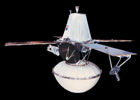 Launch: August 1975
Launch: August 1975Arrival: June 1976
Agency: NASA
Entered Mars orbit and immediately began searching for a safe landing site for the lander. The lander successfully touched down on the Mars surface taking extensive weather readings
and conducting experiments on soil samples collected with a scoop.
The orbiter was powered down in August 1980. The lander survived until November 1982.
5.
Mars 4,5,6 and 7
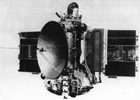 Launch: July - August 1973
Launch: July - August 1973Arrival: February - March 1974
Agency: Soviet Union
Mars 4,5,6 and 7 were rushed forward by the Soviets in an attempt to get a craft on the Martian surface before the United States.
As a result they were mostly unsuccessful. Even so they did still manage to send back some data before they're quick demise including taking
images and gathering data on the atmosphere. Notably Mars 6 did manage to launch a lander into the Martian atmosphere which broadcast data for
almost 4 minutes before abruptly cutting off.
4.
Mars 2 and 3
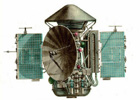 Launch: May 1971
Launch: May 1971Arrival: November - December 1971
Agency: Soviet Union
Mars 2 and 3 had the misfortune to arrive at Mars during one of the worst dust storms ever recorded there. Even so one of their landers managed to touch
down briefly on the planet's surface before being apparently blown over after only 20 seconds. The orbiters were somewhat more successful returning images,
recording temperatures and studying the Martian atmosphere.
3.
Mariner 9
 Launch: May 1971
Launch: May 1971Arrival: November 1971
Agency: NASA
The first spacecraft to go into orbit around another planet. It had to wait a month and a half to begin its mission as a dust storm had covered the entire planet.
Afterwards though it sent back a whole raft of data including over 7,000 images of Mars, the atmospheric and surface composition, density and pressure of its
atmosphere, also details about the planet's gravity and topography. On top of that it also sent back the first close up images of the two moons of Mars, Phobos and Deimos.
2.
Mariner 6 and 7
 Launch: February - March 1969
Launch: February - March 1969Arrival: July - August 1969
Agency: NASA
Mariner 6 and 7 successfully flew by Mars collecting data on the mass, radius, the shape of Mars and the
composition of its southern ice cap.
Between them they took 200 images.
1.
|
Mars Statistics
Comparison with Earth
|
Diameter: 4,212 miles (6,779 km)
Average Distance from Sun: 142 million miles (228 million km)
Orbital Period: 687 days
Rotation Period: 24.62 hours
Maximum Surface Temperatures: 20C (68F)
Minimum Surface Temperatures: -125C (-195F)
Gravity: 3.693 m/s2 (38% Earth's Gravity)
Density: 3.94 g/cm3 (71.4% Earth's Density)
Mass: 6.4185 x 1023 kg (10.7% Earth's Mass)
Volume: 1.6314 x 1011 km3 (15% Earth's Volume)
Atmosphere: 95.32% carbon dioxide, 2.7% nitrogen, 1.6% argon, 0.13% oxygen, 0.08% carbon monoxide.
Average Distance from Sun: 142 million miles (228 million km)
Orbital Period: 687 days
Rotation Period: 24.62 hours
Maximum Surface Temperatures: 20C (68F)
Minimum Surface Temperatures: -125C (-195F)
Gravity: 3.693 m/s2 (38% Earth's Gravity)
Density: 3.94 g/cm3 (71.4% Earth's Density)
Mass: 6.4185 x 1023 kg (10.7% Earth's Mass)
Volume: 1.6314 x 1011 km3 (15% Earth's Volume)
Atmosphere: 95.32% carbon dioxide, 2.7% nitrogen, 1.6% argon, 0.13% oxygen, 0.08% carbon monoxide.
Diameter: 7,926 miles (12,756 km)
Average Distance from Sun: 93 million miles (150 million km)
Orbital Period: 365.24 days
Rotation Period: 23.934 hours
Maximum Surface Temperatures: 58C (136F)
Minimum Surface Temperatures: -88C (-126F)
Gravity: 9.766 m/s2
Density: 5.515 g/cm3
Mass: 5.9737 x 1024 kg
Volume: 1.0832 x 1012 km3
Atmosphere: 78.08% nitrogen, 20.95% oxygen, 0.93% argon, 0.038% carbon dioxide.
Average Distance from Sun: 93 million miles (150 million km)
Orbital Period: 365.24 days
Rotation Period: 23.934 hours
Maximum Surface Temperatures: 58C (136F)
Minimum Surface Temperatures: -88C (-126F)
Gravity: 9.766 m/s2
Density: 5.515 g/cm3
Mass: 5.9737 x 1024 kg
Volume: 1.0832 x 1012 km3
Atmosphere: 78.08% nitrogen, 20.95% oxygen, 0.93% argon, 0.038% carbon dioxide.
Sponsored Links
